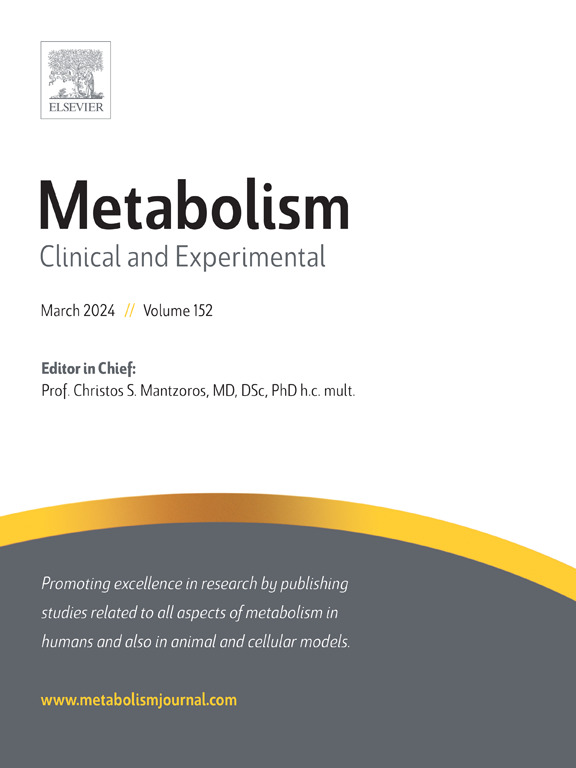Time for a change? Threshold for obesity in contemporary Japanese population
IF 11.9
1区 医学
Q1 ENDOCRINOLOGY & METABOLISM
引用次数: 0
Abstract
Background
The obesity criteria for Japanese population are defined based on a cross-sectional study conducted 30 years ago. We aimed to examine the validity of a BMI of 25 kg/m2 as a determinant of obesity in the Japanese population by assessing the association between BMI and the lifestyle-related diseases in a large and long-term cohort.
Methods
This cohort study included 162,136 individuals aged ≥40 years who participated in a medical health checkup program at Panasonic Corporation covering 166 operational sites from 2008 to 2023. The associations between BMI and the development of lifestyle-related diseases during the follow-up period were assessed using a multivariate Cox proportional hazards model. A restricted cubic spline function was applied to model the associations between BMI and disease risk. The BMI values associated with the doubling of HRs (compared with a reference BMI of 22 kg/m2) were examined.
Findings
The average follow-up duration ranged from 6 to 8 years depending on the outcome. Restricted cubic spline curves showed BMI values (kg/m2) associated with an HR of 2 (vs. 22 kg/m2): 24.6 for diabetes, 26.8 for hypertension, 32.3 for hypertriglyceridemia, 26.4 for low high-density lipoprotein cholesterol, 25 for high low-density lipoprotein cholesterol, 30.8 for coronary artery disease, 32.0 for stroke, and 25 for CKD after adjusting for covariates. Similar results were observed in subgroup analyses stratified by gender and age.
Conclusion
The appropriateness of the conventional BMI threshold of 25 kg/m2 in Japan warrants reconsideration.
是时候改变一下了?当代日本人口的肥胖阈值
日本人口的肥胖标准是根据30年前进行的一项横断面研究确定的。我们的目的是通过评估BMI与生活方式相关疾病之间的关系,在一个大型和长期的队列中,检验25 kg/m2的BMI作为日本人群肥胖决定因素的有效性。方法本队列研究纳入2008 - 2023年在松下公司166个营业点参加医疗健康检查项目的162136名年龄≥40岁的个体。使用多变量Cox比例风险模型评估随访期间BMI与生活方式相关疾病发展之间的关系。一个受限制的三次样条函数被用于模拟BMI和疾病风险之间的关联。检查与hr加倍相关的BMI值(与参考BMI为22 kg/m2相比)。根据结果,平均随访时间为6至8年。限制性三次样条曲线显示BMI值(kg/m2)与HR为2相关(vs. 22 kg/m2):调整协变量后,糖尿病为24.6,高血压为26.8,高甘油三酯血症为32.3,低高密度脂蛋白胆固醇为26.4,高低密度脂蛋白胆固醇为25,冠状动脉疾病为30.8,中风为32.0,CKD为25。在按性别和年龄分层的亚组分析中也观察到类似的结果。结论日本常规BMI阈值25 kg/m2的适宜性值得重新考虑。
本文章由计算机程序翻译,如有差异,请以英文原文为准。
求助全文
约1分钟内获得全文
求助全文
来源期刊

Metabolism: clinical and experimental
医学-内分泌学与代谢
CiteScore
18.90
自引率
3.10%
发文量
310
审稿时长
16 days
期刊介绍:
Metabolism upholds research excellence by disseminating high-quality original research, reviews, editorials, and commentaries covering all facets of human metabolism.
Consideration for publication in Metabolism extends to studies in humans, animal, and cellular models, with a particular emphasis on work demonstrating strong translational potential.
The journal addresses a range of topics, including:
- Energy Expenditure and Obesity
- Metabolic Syndrome, Prediabetes, and Diabetes
- Nutrition, Exercise, and the Environment
- Genetics and Genomics, Proteomics, and Metabolomics
- Carbohydrate, Lipid, and Protein Metabolism
- Endocrinology and Hypertension
- Mineral and Bone Metabolism
- Cardiovascular Diseases and Malignancies
- Inflammation in metabolism and immunometabolism
 求助内容:
求助内容: 应助结果提醒方式:
应助结果提醒方式:


